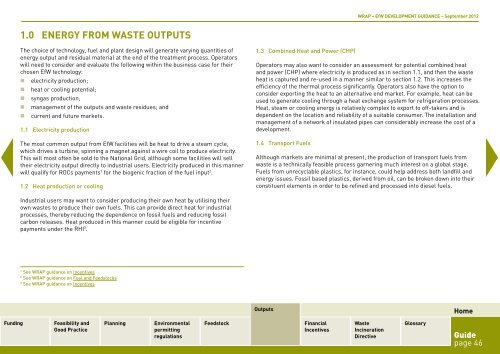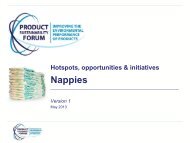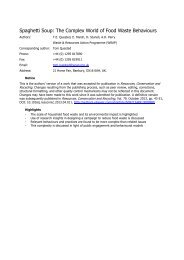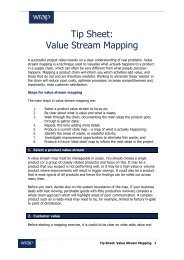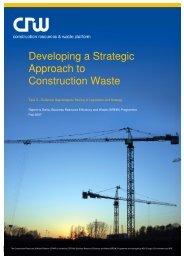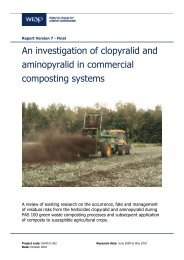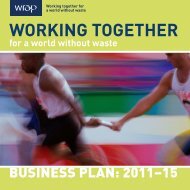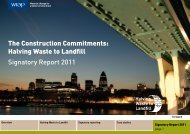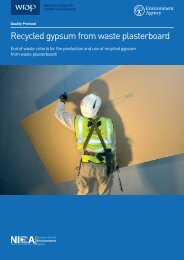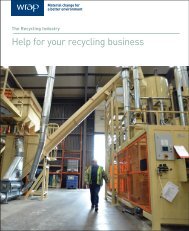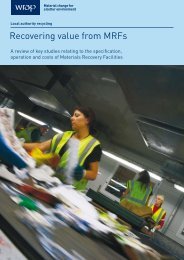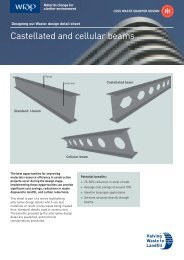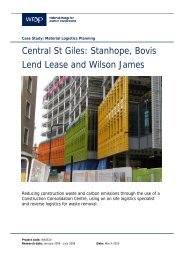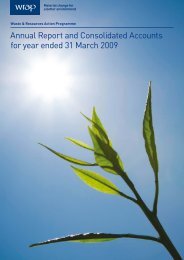EfW DEVELOPMENT GUIDANCE - Wrap
EfW DEVELOPMENT GUIDANCE - Wrap
EfW DEVELOPMENT GUIDANCE - Wrap
Create successful ePaper yourself
Turn your PDF publications into a flip-book with our unique Google optimized e-Paper software.
WRAP – <strong>EfW</strong> <strong>DEVELOPMENT</strong> <strong>GUIDANCE</strong> – September 2012<br />
1.0 Energy from waste outputs<br />
The choice of technology, fuel and plant design will generate varying quantities of<br />
energy output and residual material at the end of the treatment process. Operators<br />
will need to consider and evaluate the following within the business case for their<br />
chosen <strong>EfW</strong> technology:<br />
• electricity production;<br />
• heat or cooling potential;<br />
• syngas production,<br />
• management of the outputs and waste residues; and<br />
• current and future markets.<br />
1.1 Electricity production<br />
The most common output from <strong>EfW</strong> facilities will be heat to drive a steam cycle,<br />
which drives a turbine, spinning a magnet against a wire coil to produce electricity.<br />
This will most often be sold to the National Grid, although some facilities will sell<br />
their electricity output directly to industrial users. Electricity produced in this manner<br />
will qualify for ROCs payments 1 for the biogenic fraction of the fuel input 2 .<br />
1.2 Heat production or cooling<br />
1.3 Combined Heat and Power (CHP)<br />
Operators may also want to consider an assessment for potential combined heat<br />
and power (CHP) where electricity is produced as in section 1.1, and then the waste<br />
heat is captured and re-used in a manner similar to section 1.2. This increases the<br />
efficiency of the thermal process significantly. Operators also have the option to<br />
consider exporting the heat to an alternative end market. For example, heat can be<br />
used to generate cooling through a heat exchange system for refrigeration processes.<br />
Heat, steam or cooling energy is relatively complex to export to off-takers and is<br />
dependent on the location and reliability of a suitable consumer. The installation and<br />
management of a network of insulated pipes can considerably increase the cost of a<br />
development.<br />
1.4 Transport Fuels<br />
Although markets are minimal at present, the production of transport fuels from<br />
waste is a technically feasible process garnering much interest on a global stage.<br />
Fuels from unrecyclable plastics, for instance, could help address both landfill and<br />
energy issues. Fossil based plastics, derived from oil, can be broken down into their<br />
constituent elements in order to be refined and processed into diesel fuels.<br />
Industrial users may want to consider producing their own heat by utilising their<br />
own wastes to produce their own fuels. This can provide direct heat for industrial<br />
processes, thereby reducing the dependence on fossil fuels and reducing fossil<br />
carbon releases. Heat produced in this manner could be eligible for incentive<br />
payments under the RHI 3 .<br />
1<br />
See WRAP guidance on Incentives<br />
2<br />
See WRAP guidance on Fuel and Feedstocks<br />
3<br />
See WRAP guidance on Incentives<br />
Outputs<br />
Home<br />
Funding<br />
Feasibility and<br />
Good Practice<br />
Planning<br />
Environmental<br />
permitting<br />
regulations<br />
Feedstock<br />
Financial<br />
Incentives<br />
Waste<br />
Incineration<br />
Directive<br />
Glossary<br />
Guide<br />
page 46


